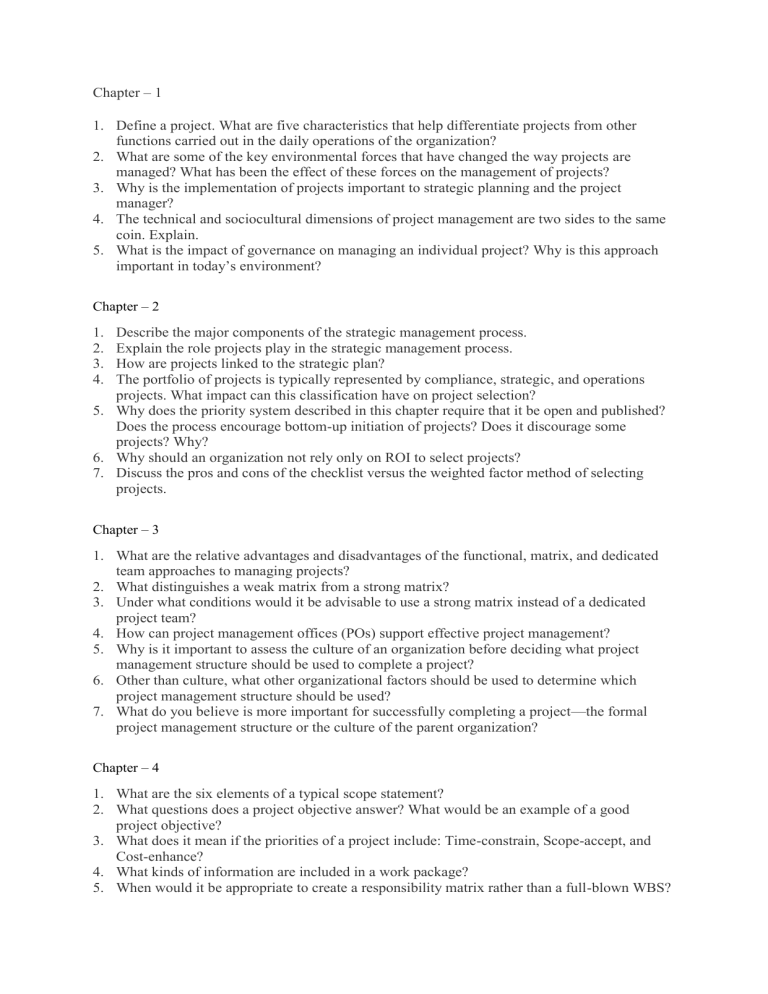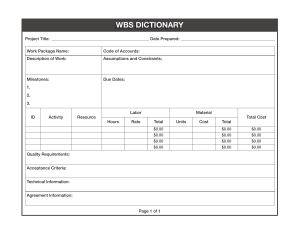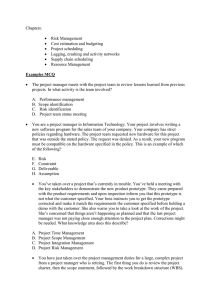
Chapter – 1 1. Define a project. What are five characteristics that help differentiate projects from other functions carried out in the daily operations of the organization? 2. What are some of the key environmental forces that have changed the way projects are managed? What has been the effect of these forces on the management of projects? 3. Why is the implementation of projects important to strategic planning and the project manager? 4. The technical and sociocultural dimensions of project management are two sides to the same coin. Explain. 5. What is the impact of governance on managing an individual project? Why is this approach important in today’s environment? Chapter – 2 1. 2. 3. 4. Describe the major components of the strategic management process. Explain the role projects play in the strategic management process. How are projects linked to the strategic plan? The portfolio of projects is typically represented by compliance, strategic, and operations projects. What impact can this classification have on project selection? 5. Why does the priority system described in this chapter require that it be open and published? Does the process encourage bottom-up initiation of projects? Does it discourage some projects? Why? 6. Why should an organization not rely only on ROI to select projects? 7. Discuss the pros and cons of the checklist versus the weighted factor method of selecting projects. Chapter – 3 1. What are the relative advantages and disadvantages of the functional, matrix, and dedicated team approaches to managing projects? 2. What distinguishes a weak matrix from a strong matrix? 3. Under what conditions would it be advisable to use a strong matrix instead of a dedicated project team? 4. How can project management offices (POs) support effective project management? 5. Why is it important to assess the culture of an organization before deciding what project management structure should be used to complete a project? 6. Other than culture, what other organizational factors should be used to determine which project management structure should be used? 7. What do you believe is more important for successfully completing a project—the formal project management structure or the culture of the parent organization? Chapter – 4 1. What are the six elements of a typical scope statement? 2. What questions does a project objective answer? What would be an example of a good project objective? 3. What does it mean if the priorities of a project include: Time-constrain, Scope-accept, and Cost-enhance? 4. What kinds of information are included in a work package? 5. When would it be appropriate to create a responsibility matrix rather than a full-blown WBS? 6. How does a communication plan benefit management of projects? Chapter – 5 1. Why are accurate estimates critical to effective project management? 2. How does the culture of an organization influence the quality of estimates? 3. What are the differences between bottom-up and top-down estimating approaches? Under what conditions would you prefer one over the other? 4. What are the major types of costs? Which costs are controllable by the project manager? 5. Why is it difficult to estimate mega project (e.g., airports, stadiums, etc.) costs and benefits? 6. Define what a “white elephant” is in project management. Provide a real-life example. Chapter – 6 1. How does the WBS differ from the project network? Ans: a. The WBS is hierarchical while the project network is sequential. b. The network provides a project schedule by identifying sequential dependencies and timing of project activities. The network sets all project work, resource needs, and budgets into a sequential time frame. the WBS does not provide this information. c. The WBS is used to identify each project deliverable and the organization unit responsible for its accomplishment within budget and within a time duration. d. The WBS provides a framework for tracking costs to deliverables and organization units responsible. 2. How are WBS and project networks linked? Ans: The network uses the time estimates found in the work packages of the WBS to develop the network. Remember, the time estimates, budgets, and resources required for a work package in the WBS are set in time frames, but without dates. The dates are computed after the network is developed An activity that spans over a segment of a project. Duration of hammock activities is determined after the network plan is drawn. Hammock activities are used to aggregate sections of the project to facilitate getting the right amount of detail for specific sections of a project. 3. Why bother creating a WBS? Why not go straight to a project network and forget the WBS? Ans: The WBS is designed to provide different information for decision making. For example, this database provides information for the following types of decisions: a. Link deliverables, organization units, and customer b. Provide for control c. Isolate problems to source d. Track schedule and cost variance. Network doesn't. e. Assign responsibility and budgets f. Focus attention on deliverables g. Provide information for different levels in the organization. 4. Why is slack important to the project manager? Ans: Slack is important to the project manager because it represents the degree of flexibility the project manager will have in rearranging work and resources. A project network with several near critical paths and hence, little slack, gives the project manager little flexibility in changing resources or rearranging work. 5. What is the difference between free slack and total slack? Ans: Free slack usually occurs at the end of an activity chain—before a merge activity. It is the amount of time the activity can be delayed without affecting the early start of the activity immediately following it. Since free slack can be delayed without delaying following activities, it gives some resource flexibility to the project manager. Total slack is the amount of time an activity can be delayed before it becomes critical. Use of total slack prevents its use on a following activity. 6. Why are lags used in developing project networks? Ans: Two major reasons: a. To closer represent real situations found in projects b. To allow work to be accomplished in parallel when the finish-to-start relationship is too restrictive. 7. What is a hammock activity, and when is it used? Ans: A hammock activity is a special purpose activity that exists over a segment of the life of the project. A hammock activity typically uses resources and is handled as an overhead cost—e.g., inspection. Hammock activities are used to identify overhead resources or costs tied directly to the project. The hammock duration is determined by the beginning of the first of a string of activities and the ending of the last activity in the string. Hammock activities are also used to aggregate sections of projects to avoid project detail—e.g., covering a whole subnetwork within a project. This approach gives top management an overview of the project by avoiding detail. Chapter – 7 1. Project risks can/cannot be eliminated if the project is carefully planned. Explain. 2. The chances of risk events occurring and their respective costs increasing change over the project life cycle. What is the significance of this phenomenon to a project manager? 3. What is the difference between avoiding a risk and accepting a risk? 4. What is the difference between mitigating a risk and contingency planning? 5. Explain the difference between budget reserves and management reserves. 6. How are the work breakdown structure and change control connected? 7. What are the likely outcomes if a change control process is not used? Why? 8. What are the major differences between managing negative risks versus positive risks (opportunities)? Chapter – 8 1. 2. 3. 4. How does resource scheduling tie to project priority? How does resource scheduling reduce flexibility in managing projects? Present six reasons scheduling resources is an important task. How can outsourcing project work alleviate the three most common problems associated with multiproject resource scheduling? 5. Explain the risks associated with leveling resources, compressing or crashing projects, and imposed durations or “catch-up” as the project is being implemented. 6. Why is it critical to develop a time-phased baseline? Chapter – 9 1. What are five common reasons for crashing a project? 2. What are the advantages and disadvantages of reducing project scope to accelerate a project? What can be done to reduce the disadvantages? 3. Why is scheduling overtime a popular choice for getting projects back on schedule? What are the potential problems for relying on this option? 4. Identify four indirect costs you might find on a moderately complex project. Why are these costs classified as indirect? 5. How can a cost–duration graph be used by the project manager? Explain. 6. Reducing the project duration increases the risk of being late. Explain. 7. It is possible to shorten the critical path and save money. Explain how. Chapter – 10 1. What is the difference between leading and managing a project? 2. Why is a conductor of an orchestra an appropriate metaphor for being a project manager? What aspects of project managing are not reflected by this metaphor? Can you think of other metaphors that would be appropriate? 3. What does the exchange model of influence suggest you do to build cooperative relationships to complete a project? 4. What differences would you expect to see between the kinds of influence currencies that a project manager in a functional matrix would use and the influence a project manager of a dedicated project team would use? 5. Why is it important to build a relationship before you need it? 6. Why is it critical to keep the project sponsor informed? 7. Why is trust a function of both character and competence? 8. Which of the eight traits/skills associated with being an effective project manager is the most important? The least important? Why? Chapter – 11 1. What are the differences between the five-stage model of team development and the punctuated equilibrium model? 2. What are the elements of an effective project vision? Why are they important? 3. Why should a project manager emphasize group rewards over individual rewards? 4. What is the difference between functional and dysfunctional conflict on a project? 5. When would it be appropriate to hold a formal team-building session on a project? 6. What are the unique challenges to managing a virtual project team? 7. What can a project manager do to avoid some of the pitfalls of a highly cohesive project team? Chapter – 13 1. How does a tracking Gantt chart help communicate project progress? 2. How does earned value give a clearer picture of project schedule and cost status than a simple plan versus actual system? 3. Schedule variance (SV) is in dollars and does not directly represent time. Why is it still useful? 4. How would a project manager use the CPI? 5. What are the differences between BAC and EAC? 6. Why is it important for project managers to resist changes to the project baseline? Under what conditions would a project manager make changes to a baseline? When would a project manager not allow changes to a baseline? Chapter – 14 1. How does the project closure review differ from the performance measurement control system discussed in Chapter 13? 2. What major information would you expect to find in a project review? 3. Why is it difficult to perform a truly independent, objective review? 4. Comment on the following statement: “We cannot afford to terminate the project now. We have already spent more than 50 percent of the project budget.” 5. Why should you separate performance reviews from pay reviews? How do you do this? 6. Advocates of retrospective methodology claim there are distinguishing characteristics that increase its value over past lessons learned methods. What are they? How does each characteristic enhance project closure and review?

